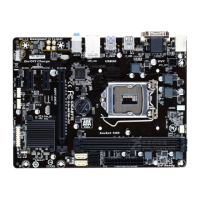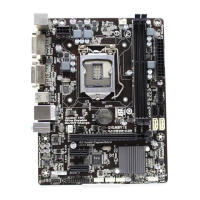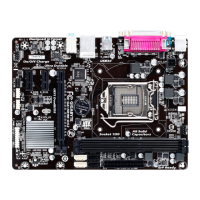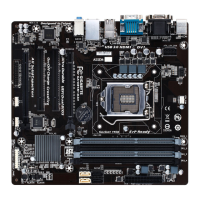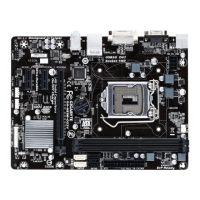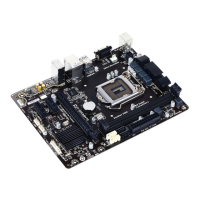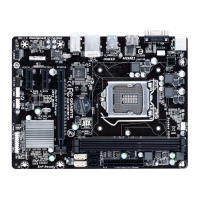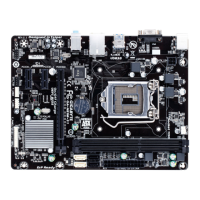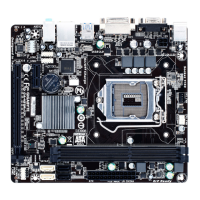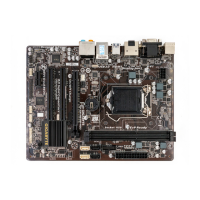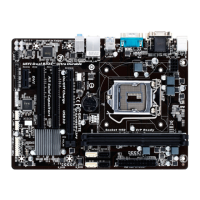Do you have a question about the Gigabyte GA-H81M-D2V and is the answer not in the manual?
Manual copyright, disclaimer, and GIGABYTE's rights.
Instructions to find the motherboard's revision number.
Visual representation of motherboard components and connectors.
List of items included in the motherboard package.
Safety guidelines and precautions before hardware installation.
Detailed specifications for motherboard hardware components.
Step-by-step guide for installing the Central Processing Unit.
Instructions for installing DDR3 memory modules.
Guidelines for installing expansion cards into PCI Express slots.
Description of motherboard rear panel connectors.
Identification and purpose of internal motherboard connectors.
Overview of BIOS startup screen and navigation methods.
Monitor and adjust system frequencies, voltages, and performance.
System model, BIOS version, date, time, and language settings.
Settings for boot order, security, and system startup options.
Settings for onboard graphics, audio, USB, and SATA controllers.
Options for controlling system power states and wake-up events.
Options for saving changes, loading defaults, and exiting BIOS.
Instructions for installing motherboard drivers after OS installation.
General notices, RoHS, WEEE, and environmental protection statements.
Specific FCC regulations applicable to Class B digital devices.
Compliance information for Canadian ICES-003 and RSS-210 standards.
Company address, phone numbers, and websites for support.
Link and instructions for submitting technical or sales inquiries online.
Manual copyright, disclaimer, and GIGABYTE's rights.
Instructions to find the motherboard's revision number.
Visual representation of motherboard components and connectors.
List of items included in the motherboard package.
Safety guidelines and precautions before hardware installation.
Detailed specifications for motherboard hardware components.
Step-by-step guide for installing the Central Processing Unit.
Instructions for installing DDR3 memory modules.
Guidelines for installing expansion cards into PCI Express slots.
Description of motherboard rear panel connectors.
Identification and purpose of internal motherboard connectors.
Overview of BIOS startup screen and navigation methods.
Monitor and adjust system frequencies, voltages, and performance.
System model, BIOS version, date, time, and language settings.
Settings for boot order, security, and system startup options.
Settings for onboard graphics, audio, USB, and SATA controllers.
Options for controlling system power states and wake-up events.
Options for saving changes, loading defaults, and exiting BIOS.
Instructions for installing motherboard drivers after OS installation.
General notices, RoHS, WEEE, and environmental protection statements.
Specific FCC regulations applicable to Class B digital devices.
Compliance information for Canadian ICES-003 and RSS-210 standards.
Company address, phone numbers, and websites for support.
Link and instructions for submitting technical or sales inquiries online.
| Non-ECC | Yes |
|---|---|
| Memory voltage | 1.5 V |
| Memory channels | Dual-channel |
| Memory slots type | DIMM |
| Supported memory types | DDR3-SDRAM |
| Maximum internal memory | 16 GB |
| Supported memory clock speeds | 1333, 1600 MHz |
| Processor socket | LGA 1150 (Socket H3) |
| Processor manufacturer | Intel |
| Compatible processor series | Intel Celeron, Intel Pentium |
| USB 2.0 connectors | 2 |
| Number of Parallel ATA connectors | - |
| USB 3.2 Gen 1 (3.1 Gen 1) connectors | 1 |
| eSATA ports quantity | 0 |
| USB 2.0 ports quantity | USB 2.0 ports have a data transmission speed of 480 Mbps, and are backwards compatible with USB 1.1 ports. You can connect all kinds of peripheral devices to them. |
| USB 3.2 Gen 1 (3.1 Gen 1) Type-A ports quantity | 4 |
| Component for | PC |
| Power source type | ATX |
| Motherboard chipset | Intel® H81 |
| PC health monitoring | CPU, FAN, Temperature |
| Audio output channels | 7.1 channels |
| Motherboard form factor | micro ATX |
| Supported storage drive interfaces | SATA II, SATA III |
| Maximum resolution | 1920 x 1200 pixels |
| Maximum graphics card memory | 1024 MB |
| Bundled software | Norton Internet Security |
| Ethernet interface type | Gigabit Ethernet |
| BIOS type | EFI AMI |
| ACPI version | 2.0a |
| BIOS memory size | 128 Mbit |
| PCI Express slots quantity | 3 |
| Intel® vPro™ Platform Eligibility | No |
| Depth | 174 mm |
|---|---|
| Width | 226 mm |
